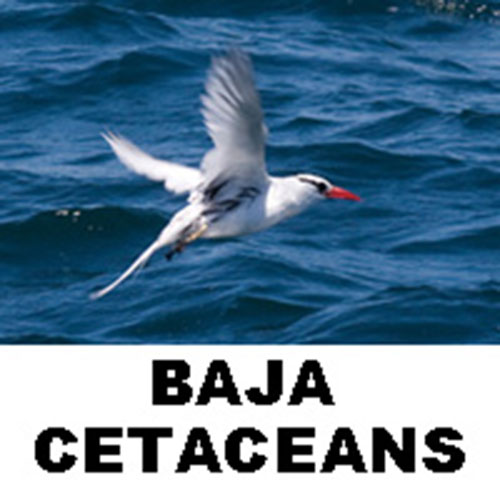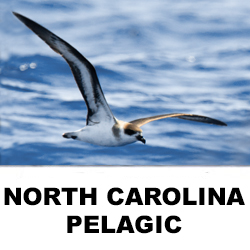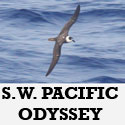|
 As part of catching up from restrictions due to Covid I decided to have a break from organising my own trips, and decided to go to Kazakhstan with Birdfinders. I had looked into "going it alone"
but it would be very difficult and not really practical unless you speak Russian. There was an extension which tempted me as I would get two species I particularly wanted to see which have
occured in the UK, plus Caspian Plover which was then my "most-wanted plover", having missed them in Kazakhstan 30 years ago, and dipped in the UK at least twice.
As part of catching up from restrictions due to Covid I decided to have a break from organising my own trips, and decided to go to Kazakhstan with Birdfinders. I had looked into "going it alone"
but it would be very difficult and not really practical unless you speak Russian. There was an extension which tempted me as I would get two species I particularly wanted to see which have
occured in the UK, plus Caspian Plover which was then my "most-wanted plover", having missed them in Kazakhstan 30 years ago, and dipped in the UK at least twice.
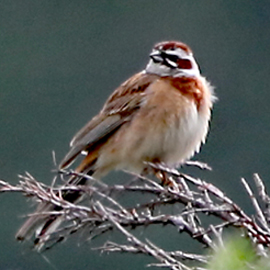 Monday 23rd May.
Monday 23rd May.
After a somewhat fraught journey from Heathrow involving a nearly missed connection our group of birders arrived in Almaty to find that a piece of luggage (mine) was still in Istanbul.
In typical birder fashion we continued to our hotel on the outskirts of the city in an area with a good bit of habitat remaining. I had visited Kazakhstan some thirty years earlier and
remarked that the city was much larger with more traffic, but once in the “suburbs” plenty of areas looked good for birds, and so it proved. At the hotel we met with Sveta, our guide,
and the rest of our party, some of whom had been touring Uzbekistan. Sveta is from the area and possibly the best guide in Kazakhstan as well as being Vaughan’s wife. So, apart from one piece of
luggage we were all set, and after a short rest, lunch and settling in we set off to find our first target, Meadow Bunting, which only seems to occur in a small area not far from the
old capital. It wasn't particularly warm, but Jonathan offered me the use of a jumper until I could access my luggage. We got on well throughout the tour, and now intend to travel to Ghana
together.
Settling in had included birding the hotel grounds, which produced Azure Tit for me and my room-mate from our window. Whilst the commonest birds were Great Tits, by the time we
moved on the next day many of the group had seen Blue Whistling Thrush, the pretty Azure Tit, and Brown Dipper (really close views on the nearby river).
On arrival at the Bunting site we heard song but could not find the source, so set off along the track. Our first bunting was in fact Grey-necked, which is rare in the area, and after
some discussion involving Ortolan, and examination of photos, it turned out Sveta was right all along, a lifer for several of the group. Corn and Ortolan Buntings were in evidence,
and we were beginning to be concerned when a bird flew in and landed just off the track. A bit of repositioning, both on our part and the bird’s, and we were all watching a male Meadow
Bunting singing on top of a bush. Definitely one of the most attractive buntings. Mission accomplished, but we continued on, soon adding a few species to the trip list, including Calandra
Lark, European Roller and Chukar. Sadly raptors were not much in evidence, but we did see a somewhat distant Golden Eagle. We eventually proceeded back to our hotel, stopping off at a
tree-lined area which added a few more species, including Oriental Turtle Dove (meena) and the local race of Woodpigeon, which does look somewhat different to the one we are used to.
A Golden Oriole was heard but not tracked down, so an early meal and bed were next on the agenda.
 Tuesday 24th May.
Tuesday 24th May.
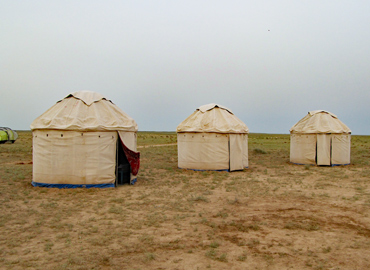 Sveta had obviously been busy during the evening as the missing luggage arrived whilst we were having breakfast, and our early start for the next part of our adventure wasn’t delayed by much,
so we set off for our yurt camp in the Saryesik Atyrau desert, once it was determined everyone had caught up with Azure Tit. Although quite a distance, the plan was to visit Sorbulak en route,
a series of lakes including one large one, which gave us plenty of birding time. Possibly the most wanted species in this area is Dalmatian Pelican, along with Great White, and these proved
quite easy on the main lake. Other lakes yielded a number of species familiar to most British birders, but vagrants in the UK, such as Terek Sandpiper, Temminck’s Stint, Red-crested Pochard,
Ferruginous Duck, Gull-billed Tern, and eventually an elusive White-headed Duck. Whether this last is a genuine vagrant to the UK is a moot point, but none has occurred since we killed all the Ruddies.
We had a better day for raptors; our first Long-legged Buzzard and a Himalayan Griffon drifted overhead, whilst a Shikra, the only one of the tour, showed well but sadly decided to fly off before
everyone had seen it. Ruddy Shelducks were frequently seen, a pair with shelducklings at one stop, near the Magic Tree. Sadly now dead, the large numbers of migrants responsible for its name are
no more, but Pied and Isabelline Wheatears and Rosy Starlings were in evidence, and Rufous Bushchat put in an appearance. A stop after the lakes, however, gave us a real sting in the tail. Whilst
some were buying snacks the others were chasing a Common Rosefinch around a bush, when a second bird caught our attention. It turned out to be a Long-tailed Shrike, unexpected and a rare sighting
on the tour.
Approaching Konchegil we began to see familiar birds of the area, although the main target here, particularly for me, was Caspian Plover. We arrived in the afternoon, settled in to the camp and set
off in to the desert. Although a true desert in terms of rainfall, there is much low vegetation and several small lakes (or large ponds) which have varying degrees of water. These attract Sandgrouse,
mainly Black-bellied but also Pallas’ which was also on everyone’s wish list. We were told the nature of our task by Sveta, namely the area is vast, many of the birds are thinly distributed, Pallas’
Sandgrouse hadn’t been seen by a previous group visiting the area, and McQueen’s Bustard had retreated to inaccessible areas courtesy of Arab falconers. In addition only female Caspian Plovers had
been seen over the past few years (they are on the southern limit of their breeding range). But we were British birders, so we would try our hardest. A great spot by Julie on our first evening set
pulses racing; it was a Greater Sand Plover, however. Still a great bird which gave good prolonged views, oddly the only one we saw on the trip. We continued our exploration near the camp, seeing
Black-bellied Sandgrouse in flight and occasionally on the ground. Visiting various water sources yielded some of the area’s passerines, Pied and Isabelline Wheatears, Rosy Starling, Red-headed
Bunting and Rufous Bushchat (or whatever they call it these days!). Sparrows were interesting, our only Spanish of the tour, and Indian Sparrow which is a non-migratory race of House, thought to
be a potential split by some. A Swallowtail butterfly was a brief visitor, presumably migrating since there were more lizards than butterflies in the area.
Then we stopped to scan and I thought I saw a couple of suspicious looking humps in the grass. Alerting the others, the humps started to move and eventually we were all watching a pair of Pallas’
Sandgrouse. They were just close enough to photograph, no one left the bus but eventually they took off into the vast landscape. Strangely, during our stay in the area we saw at least another two
pairs, which shows the vagaries of birding such a large area. Despite a dodgy generator in the camp our evening meal was a happy affair after our great start to our time in the desert and although
we had somewhat fragile looking camp beds everyone reported a good night’s sleep in comfort.
Sveta had obviously been busy during the evening as the missing luggage arrived whilst we were having breakfast, and our early start for the next part of our adventure wasn’t delayed by much,
so we set off for our yurt camp in the Saryesik Atyrau desert, once it was determined everyone had caught up with Azure Tit. Although quite a distance, the plan was to visit Sorbulak en route,
a series of lakes including one large one, which gave us plenty of birding time. Possibly the most wanted species in this area is Dalmatian Pelican, along with Great White, and these proved
quite easy on the main lake. Other lakes yielded a number of species familiar to most British birders, but vagrants in the UK, such as Terek Sandpiper, Temminck’s Stint, Red-crested Pochard,
Ferruginous Duck, Gull-billed Tern, and eventually an elusive White-headed Duck. Whether this last is a genuine vagrant to the UK is a moot point, but none has occurred since we killed all the Ruddies.
We had a better day for raptors; our first Long-legged Buzzard and a Himalayan Griffon drifted overhead, whilst a Shikra, the only one of the tour, showed well but sadly decided to fly off before
everyone had seen it. Ruddy Shelducks were frequently seen, a pair with shelducklings at one stop, near the Magic Tree. Sadly now dead, the large numbers of migrants responsible for its name are
no more, but Pied and Isabelline Wheatears and Rosy Starlings were in evidence, and Rufous Bushchat put in an appearance. A stop after the lakes, however, gave us a real sting in the tail. Whilst
some were buying snacks the others were chasing a Common Rosefinch around a bush, when a second bird caught our attention. It turned out to be a Long-tailed Shrike, unexpected and a rare sighting
on the tour.
Approaching Konchegil we began to see familiar birds of the area, although the main target here, particularly for me, was Caspian Plover. We arrived in the afternoon, settled in to the camp and set
off in to the desert. Although a true desert in terms of rainfall, there is much low vegetation and several small lakes (or large ponds) which have varying degrees of water. These attract Sandgrouse,
mainly Black-bellied but also Pallas’ which was also on everyone’s wish list. We were told the nature of our task by Sveta, namely the area is vast, many of the birds are thinly distributed, Pallas’
Sandgrouse hadn’t been seen by a previous group visiting the area, and McQueen’s Bustard had retreated to inaccessible areas courtesy of Arab falconers. In addition only female Caspian Plovers had
been seen over the past few years (they are on the southern limit of their breeding range). But we were British birders, so we would try our hardest. A great spot by Julie on our first evening set
pulses racing; it was a Greater Sand Plover, however. Still a great bird which gave good prolonged views, oddly the only one we saw on the trip. We continued our exploration near the camp, seeing
Black-bellied Sandgrouse in flight and occasionally on the ground. Visiting various water sources yielded some of the area’s passerines, Pied and Isabelline Wheatears, Rosy Starling, Red-headed
Bunting and Rufous Bushchat (or whatever they call it these days!). Sparrows were interesting, our only Spanish of the tour, and Indian Sparrow which is a non-migratory race of House, thought to
be a potential split by some. A Swallowtail butterfly was a brief visitor, presumably migrating since there were more lizards than butterflies in the area.
Then we stopped to scan and I thought I saw a couple of suspicious looking humps in the grass. Alerting the others, the humps started to move and eventually we were all watching a pair of Pallas’
Sandgrouse. They were just close enough to photograph, no one left the bus but eventually they took off into the vast landscape. Strangely, during our stay in the area we saw at least another two
pairs, which shows the vagaries of birding such a large area. Despite a dodgy generator in the camp our evening meal was a happy affair after our great start to our time in the desert and although
we had somewhat fragile looking camp beds everyone reported a good night’s sleep in comfort.
Wednesday 25th May.
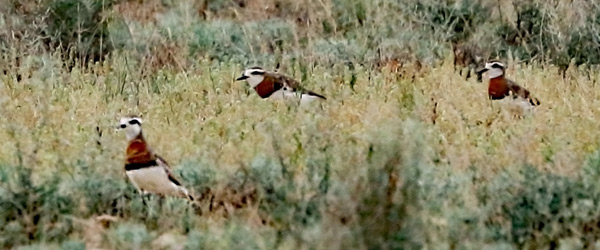 The following morning everyone was up early, eager to begin our search. Up with the lark in fact, in this case Turkestan Short-toed. Greater Short-toed were also around, allowing a comparison,
although the call is distinctly different, so it is quite easy to pick them up in flight. We firstly visited an area where Sveta had seen the plover before but thorough searching revealed only more
larks, Crested, Calandra and a brief Bimaculated. We then went to an area where a previous tour group had seen a (probably) nesting female. We set up scopes to scan the area, a few passerines were
seen, and then Nick called me to his scope. Although needing no confirmation, Nick asked me what I was seeing. Soon everyone was watching a Caspian Plover! We approached slowly in stages although
careful not to cause disturbance. At one point the bird sat as if on a nest, but then one of the hazards of nesting here became apparent when we watched helplessly as a large herd of goats traversed
the area. The bird certainly was unharmed, at least, and didn’t seem unduly agitated. My 200th wader for the world was finally nailed!
But whilst this was going on the icing on the cake arrived. Three, yes three, full breeding plumaged males appeared as if from nowhere, flew towards us, round the tour bus, and back to the area they
had come from. This is not poetic licence; they really did fly round the tour bus! They remained in view for some time, and we left them a very happy group. We continued in the slight hope of finding
a McQueen’s Bustard to no avail, although Nick became our long range scanner when he picked up a bird on the distant horizon. It was a bustard, but a Little, the only one of the trip. A brief look at
what looked like an abandoned farm proved a worthwhile stop. Owls aren’t a major feature of this trip, but a (Desert) Little Owl showed well, a possible split? Other species included a female Desert
Finch, which was fortunate since a later site failed to produce, Syke’s Warbler and Indian Golden Oriole, presumably a late migrant. Having seen our main target early in the day meant we still had
time in the area, so Sveta led us to a fairly new site where a pair of Eastern Rock Nuthatches has bred for several years. Once again we had news that a previous tour group had failed to see them,
but we all saw the birds well before they flew off along the gorge. Whilst not a new bird for everyone certainly a rarity in Kazakhstan. Again, raptors were not much in evidence, Black-eared Kite,
Common Kestrel and Long-legged Buzzard being about it, but nobody was complaining at the end of a long and varied day, one of the last sightings was another pair of Pallas’ Sandgrouse. Goitered Gazelles
were also a feature of the area and were seen on several occasions. .
The following morning everyone was up early, eager to begin our search. Up with the lark in fact, in this case Turkestan Short-toed. Greater Short-toed were also around, allowing a comparison,
although the call is distinctly different, so it is quite easy to pick them up in flight. We firstly visited an area where Sveta had seen the plover before but thorough searching revealed only more
larks, Crested, Calandra and a brief Bimaculated. We then went to an area where a previous tour group had seen a (probably) nesting female. We set up scopes to scan the area, a few passerines were
seen, and then Nick called me to his scope. Although needing no confirmation, Nick asked me what I was seeing. Soon everyone was watching a Caspian Plover! We approached slowly in stages although
careful not to cause disturbance. At one point the bird sat as if on a nest, but then one of the hazards of nesting here became apparent when we watched helplessly as a large herd of goats traversed
the area. The bird certainly was unharmed, at least, and didn’t seem unduly agitated. My 200th wader for the world was finally nailed!
But whilst this was going on the icing on the cake arrived. Three, yes three, full breeding plumaged males appeared as if from nowhere, flew towards us, round the tour bus, and back to the area they
had come from. This is not poetic licence; they really did fly round the tour bus! They remained in view for some time, and we left them a very happy group. We continued in the slight hope of finding
a McQueen’s Bustard to no avail, although Nick became our long range scanner when he picked up a bird on the distant horizon. It was a bustard, but a Little, the only one of the trip. A brief look at
what looked like an abandoned farm proved a worthwhile stop. Owls aren’t a major feature of this trip, but a (Desert) Little Owl showed well, a possible split? Other species included a female Desert
Finch, which was fortunate since a later site failed to produce, Syke’s Warbler and Indian Golden Oriole, presumably a late migrant. Having seen our main target early in the day meant we still had
time in the area, so Sveta led us to a fairly new site where a pair of Eastern Rock Nuthatches has bred for several years. Once again we had news that a previous tour group had failed to see them,
but we all saw the birds well before they flew off along the gorge. Whilst not a new bird for everyone certainly a rarity in Kazakhstan. Again, raptors were not much in evidence, Black-eared Kite,
Common Kestrel and Long-legged Buzzard being about it, but nobody was complaining at the end of a long and varied day, one of the last sightings was another pair of Pallas’ Sandgrouse. Goitered Gazelles
were also a feature of the area and were seen on several occasions. .
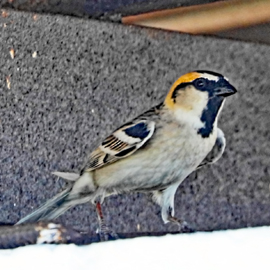 Thursday 26th May
Thursday 26th May
Used to early starts by now we travelled north in the desert towards Lake Balkash, our destination being a Turanga grove near Zheltornga. Turanga, or Asian Poplar, groves serve as a shelter during summer
heat and fierce drought, the trees being adapted to be suitable for growing in sandy and saline areas. As such they support species which are not found elsewhere in Kazakhstan, especially White-winged
Woodpecker and Pale-backed Pigeon. However, there was a lot to look out for on our journey, including another speciality. Sveta had decided that Asian Desert Warbler deserved special attention, since
she felt we should have seen one by now, but our first stop didn’t produce. We did however add some birds to the list, Great Grey Shrike (pallidirostris), and Lesser Whitethroat (halimodendri), plus better
views of Rufous Bushchat, Red-tailed Shrike and Red-headed Bunting. Further stops added another potential split in feldegg Yellow Wagtail, known as Black-headed Wagtail. Split or not, they are really smart
wagtails and well worth stopping for, along with the personata race of white Wagtail (Masked Wagtail) which is somewhat more widespread. We saw our first Northern Lapwings, not that we actually stopped for
them, but Common Pratincoles were flying over the same area, albeit somewhat distant. We did stop however, for a White-tailed Eagle which gave excellent views, especially as it was an adult. Our best bet
for the species had been in the Sorbulak area, but of course we saw none there, the vagaries of birding! Eventually we stopped at a site where everyone finally caught up with Asian Desert Warbler, thanks
to Sveta’s persistence. Syke’s Warbler also showed well here, both species familiar to (some) British twitchers.
We then crossed the road to the bus-stop. No, not an economy measure, but the site of a small colony of Saxaul Sparrows, a species increasingly difficult to find these days, but a much sought-after bird by
everyone on the trip (even me, who wanted better photos). Possibly the smartest sparrow in the world, they showed well in and around the bus shelter, probably local travellers were completely oblivious to
such a rare bird watching them wait for a bus! From there we finally drove to the Turanga grove, where we spent some time, including lunch, in the grove, and eventually everyone got reasonable flight views
of the pigeon (formerly known as Eversmann’s or Yellow-eyed Stock Dove). Why they are so wary is a mystery, but few people manage to see them perched. Bukhara Tit (formerly split from Great Tit and now lumped)
was far easier, in the trees around our lunch site. It is different in that most yellow is replaced by white, but Great Tit is common in other areas of Kazakhstan and it must be a candidate for splitting again. The last of the three specialities, the Woodpecker, eventually showed well for most people, being very mobile most of the time although often in view for a few seconds. Two or three pairs were in the area, one of the males stayed put for some time near a nest.
With most of the birds needed in this area on the list, we made for our hotel in Kapshagai, which would put us back nearer Almaty for the next few days. Whilst probably not earning a great score on Trip
Advisor, a couple of quirks being a hundred yard walk from the bus and absolutely no second key for a shared room, our hotel was comfortable and we all had another good rest before our next day’s birding.
The walk in fact allowed me and couple of others a brief view of a Nightingale on the ground next morning before breakfast.
Friday 27th May

 The following day was based around canyons of the Charyn River, both interestingly picturesque and full of birds. Buntings were again a major target, especially White-capped, another bird subject to name
changes (also known as Chestnut-fronted) which showed well in Kokpek Gorge. Good views of this, as well as Rock and Grey-headed, in different locations, were our morning fare, but whilst waiting for an
appearance or re-appearance several other species were found, one new for the trip in the shape of a Rufous-tailed Rock Thrush. Raptors were still conspicuous by their absence, but Steppe and Golden Eagles
were around, and unfortunately a distant large falcon was unidentified. Highlight of the area for some were non-avian, especially butterflies. These included Eversmann's Apollo and Hungarian Glider among
others, the apollo in particular showing very well for those that were at the appropriate point on the path. Our afternoon consisted of more of the same, in that we visited various spots known to hold wanted
species, all without travelling far thanks to Sveta’s knowledge of the area. The first of these was a copse next to the road at which we located a White-crowned Penduline Tit. Three Penduline Tits occur in
the country, Black-capped and Penduline we never did see, although we did find a nest of the latter, obviously this year’s but the young had probably fledged. As we boarded the bus our raptor mojo finally
worked, in the shape of two Oriental Honey Buzzards flying overhead, presumably migrants. Unexpected but very welcome. A visit to a cemetery was next, interesting in itself but holding breeding Rock Sparrows
and Lesser Kestrels. The Rock Sparrows showed very well, even the yellow throat patch being readily visible, but the Kestrels, adults and juveniles, maintained their distance most of the time.
Our last visit of the afternoon found our site “occupied” by a Dutch group, complete with camping chairs. This was our only chance for several finches, in particular Mongolian, not the easiest bird to see.
The site was a well in the mountains, obviously a source of water, it was very hot and a building providing shade was the site of the Dutch chairs. We felt we couldn’t move closer to the well, but managed
to infiltrate the crowd and it all became quite friendly. Birds turned up with some regularity and showed well but somewhat distantly. Star of the show was Mongolian Finch, a beautiful tan and pink bird,
but sadly Crimson-winged and Desert Finches failed to show up. An interesting visitor was Horned Lark of the subspecies brandti, quite different from UK birds, as are many races. One day a taxonomist will
make his name sorting them out; there must be more than one species! Other birds included Rock Dove (seemingly pure) Jackdaw (Eastern race), Tawny Pipit, Isabelline Wheatear, Masked Wagtail, and Steppe Eagle
overhead. We stayed here some time in the hope of a Crimson-winged Finch, but eventually headed to our hotel. One apparently turned up after we’d left, but no-one seemed too bothered.
The next day was a “mop-up” day as we headed towards Almaty and past, back to our first hotel. We first had a look in a canyon area, where we saw another White-capped Bunting, and in the same region
found another three new birds for our list, Crag Martin, Blue Rock Thrush and Tree Sparrow. In truth, there was little to look for as the only likely spot would have been a return visit to the well,
and no-one had much enthusiasm for it, so we had a fairly easy day to prepare for the next two in the Tien Shan Mountains. One spot we did visit was an old quarry with a Sand Martin colony, among which
were some Pale Martins. Neither species was much in evidence, the quarry seemingly no longer used, although Bee-eaters and Rollers were around. This proved to be one of the biggest challenges, partly
because identification is difficult but what few birds there were remained in flight. Eventually Sveta and at least two other members, of the group, myself included, were able to get good enough views to positively identify
at least one bird as a Pale Martin. There were road works nearby, whether the colony will re-instate itself in the future remains to be seen.
A fairly early return to our hotel allowed free time to everybody, needless to say many spent it birding, little new was seen, although one or two had views of the Common Pheasant we could all hear.
This of course is a real pheasant in its original habitat, and as such is very secretive. Most people also caught up with the frustrating Blue Whistling Thrush which often gave good views, but never stayed still long
enough to get a decent photo.
The following day was based around canyons of the Charyn River, both interestingly picturesque and full of birds. Buntings were again a major target, especially White-capped, another bird subject to name
changes (also known as Chestnut-fronted) which showed well in Kokpek Gorge. Good views of this, as well as Rock and Grey-headed, in different locations, were our morning fare, but whilst waiting for an
appearance or re-appearance several other species were found, one new for the trip in the shape of a Rufous-tailed Rock Thrush. Raptors were still conspicuous by their absence, but Steppe and Golden Eagles
were around, and unfortunately a distant large falcon was unidentified. Highlight of the area for some were non-avian, especially butterflies. These included Eversmann's Apollo and Hungarian Glider among
others, the apollo in particular showing very well for those that were at the appropriate point on the path. Our afternoon consisted of more of the same, in that we visited various spots known to hold wanted
species, all without travelling far thanks to Sveta’s knowledge of the area. The first of these was a copse next to the road at which we located a White-crowned Penduline Tit. Three Penduline Tits occur in
the country, Black-capped and Penduline we never did see, although we did find a nest of the latter, obviously this year’s but the young had probably fledged. As we boarded the bus our raptor mojo finally
worked, in the shape of two Oriental Honey Buzzards flying overhead, presumably migrants. Unexpected but very welcome. A visit to a cemetery was next, interesting in itself but holding breeding Rock Sparrows
and Lesser Kestrels. The Rock Sparrows showed very well, even the yellow throat patch being readily visible, but the Kestrels, adults and juveniles, maintained their distance most of the time.
Our last visit of the afternoon found our site “occupied” by a Dutch group, complete with camping chairs. This was our only chance for several finches, in particular Mongolian, not the easiest bird to see.
The site was a well in the mountains, obviously a source of water, it was very hot and a building providing shade was the site of the Dutch chairs. We felt we couldn’t move closer to the well, but managed
to infiltrate the crowd and it all became quite friendly. Birds turned up with some regularity and showed well but somewhat distantly. Star of the show was Mongolian Finch, a beautiful tan and pink bird,
but sadly Crimson-winged and Desert Finches failed to show up. An interesting visitor was Horned Lark of the subspecies brandti, quite different from UK birds, as are many races. One day a taxonomist will
make his name sorting them out; there must be more than one species! Other birds included Rock Dove (seemingly pure) Jackdaw (Eastern race), Tawny Pipit, Isabelline Wheatear, Masked Wagtail, and Steppe Eagle
overhead. We stayed here some time in the hope of a Crimson-winged Finch, but eventually headed to our hotel. One apparently turned up after we’d left, but no-one seemed too bothered.
The next day was a “mop-up” day as we headed towards Almaty and past, back to our first hotel. We first had a look in a canyon area, where we saw another White-capped Bunting, and in the same region
found another three new birds for our list, Crag Martin, Blue Rock Thrush and Tree Sparrow. In truth, there was little to look for as the only likely spot would have been a return visit to the well,
and no-one had much enthusiasm for it, so we had a fairly easy day to prepare for the next two in the Tien Shan Mountains. One spot we did visit was an old quarry with a Sand Martin colony, among which
were some Pale Martins. Neither species was much in evidence, the quarry seemingly no longer used, although Bee-eaters and Rollers were around. This proved to be one of the biggest challenges, partly
because identification is difficult but what few birds there were remained in flight. Eventually Sveta and at least two other members, of the group, myself included, were able to get good enough views to positively identify
at least one bird as a Pale Martin. There were road works nearby, whether the colony will re-instate itself in the future remains to be seen.
A fairly early return to our hotel allowed free time to everybody, needless to say many spent it birding, little new was seen, although one or two had views of the Common Pheasant we could all hear.
This of course is a real pheasant in its original habitat, and as such is very secretive. Most people also caught up with the frustrating Blue Whistling Thrush which often gave good views, but never stayed still long
enough to get a decent photo.
Saturday 28th May
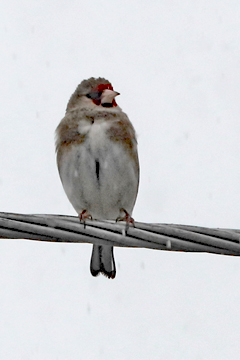
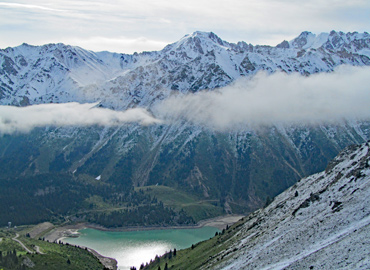
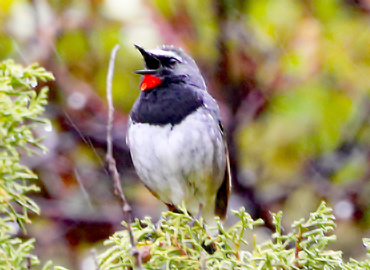 Due next was the best part of the trip for many, an ascent of the mountain road above Great Almaty Lake. However, this year was not destined to be the best in terms of weather and beaurocracy. The road had
been closed and it was touch and go whether it would be open in time, had this not happened the whole tour would have been cancelled. There was still conflicting information up until the evening before,
regarding permits etc. and indeed the situation wasn’t really clear when we set off, but Sveta doesn’t stand any nonsense and we were able to access where we wanted to be. Unfortunately no-one has control
over the weather, so most of the morning was spent in quite miserable conditions sheltering in picnic “gazebos” and birding as best we could. Low cloud was the main problem, snow showers turned to sleet and
then rain but visibility was almost non-existent. We couldn’t scan the lake for Ibisbill, we couldn’t even see it! Although it was akin to birding in fog, slowly species appeared out of the gloom. First were
flocks of Plain Mountain Finches, and gradually birds perched on the telephone wires and treetops around, including Fire-fronted Serin, Mistle Thrush (could have strung a White’s in that visibility!), Tree
Pipit, Common Cuckoo, and Goldfinch. Several people noted that although only treated as a race currently, the bill of the last was very thin and long, looking quite different to the birds at home.
(Stop press! As of April 2024 it has been split as Grey-crowned Goldfinch Carduelis caniceps {IOC})
None of the picnic areas could easily accommodate everyone, so people were moving around in brief periods when it wasn’t too wet, between us we managed to get everyone seeing the specialities as the weather
cleared, we even saw the lake from time to time. These specialities included Black-throated Accentor, Red-mantled Rosefinch and White-winged Grosbeak, but views were poor in most cases, except for one
Accentor which sang from a bush about ten yards away. The weather was improving after lunch, but we went a short distance up and decided it would be foolhardy to travel further, so we decided to leave that
until the morrow, and go looking for many people’s most wanted bird here, the magical Ibisbill. The lake was now visible and it wasn’t raining all the time, so we entered the gate and hoped the guards would
allow us to walk where we could get better views of it. Thirty years ago there was free access, but the guards here were friendly and allowed our passage, providing we didn’t try to cross the dam. The younger
(relative term) members of our band charged off with Sveta trying to keep them back, saying they would miss birds on the way. I, who couldn’t keep up anyway, tried to explain the British twitching mentality
but they were soon out of sight. Unfortunately, they did miss a single Black-headed (Brandt’s) Mountain Finch, the only one of the trip, but as the rest of the group caught up the work was done, they had
found two Ibisbills. Sadly the birds were a distance away, but far closer than if we hadn’t been allowed down the track. Good enough in a scope though. I kept quiet about the situation thirty years previously
when we were allowed to drive to the foreshore of the lake, giving views close enough to photograph the birds with a film camera. A pair of Ruddy Shelduck flew across the lake, but the
chance of more wet weather eventually persuaded everyone to begin the return, which was a lot easier, being downhill. On the way back everyone caught up with good views of the remaining specialities at this
altitude, including Eversmann’s (Rufous-backed) Redstart, Blue-capped Redstart and White-tailed Rubythroat, a bird that makes Siberian Rubythroat look dull. Also fog-free views of the Grosbeak and Red-mantled
Rosefinch, as well as several Marmots sitting at the edge of their burrows. The weather remained fairly good, and we returned to our hotel very happy with our haul. Only White-browed Tit-warbler had eluded us,
but these have been getting harder recently, other tours had reported no sign, and they don’t like inclement weather, so we hadn’t expected one anyway..
Due next was the best part of the trip for many, an ascent of the mountain road above Great Almaty Lake. However, this year was not destined to be the best in terms of weather and beaurocracy. The road had
been closed and it was touch and go whether it would be open in time, had this not happened the whole tour would have been cancelled. There was still conflicting information up until the evening before,
regarding permits etc. and indeed the situation wasn’t really clear when we set off, but Sveta doesn’t stand any nonsense and we were able to access where we wanted to be. Unfortunately no-one has control
over the weather, so most of the morning was spent in quite miserable conditions sheltering in picnic “gazebos” and birding as best we could. Low cloud was the main problem, snow showers turned to sleet and
then rain but visibility was almost non-existent. We couldn’t scan the lake for Ibisbill, we couldn’t even see it! Although it was akin to birding in fog, slowly species appeared out of the gloom. First were
flocks of Plain Mountain Finches, and gradually birds perched on the telephone wires and treetops around, including Fire-fronted Serin, Mistle Thrush (could have strung a White’s in that visibility!), Tree
Pipit, Common Cuckoo, and Goldfinch. Several people noted that although only treated as a race currently, the bill of the last was very thin and long, looking quite different to the birds at home.
(Stop press! As of April 2024 it has been split as Grey-crowned Goldfinch Carduelis caniceps {IOC})
None of the picnic areas could easily accommodate everyone, so people were moving around in brief periods when it wasn’t too wet, between us we managed to get everyone seeing the specialities as the weather
cleared, we even saw the lake from time to time. These specialities included Black-throated Accentor, Red-mantled Rosefinch and White-winged Grosbeak, but views were poor in most cases, except for one
Accentor which sang from a bush about ten yards away. The weather was improving after lunch, but we went a short distance up and decided it would be foolhardy to travel further, so we decided to leave that
until the morrow, and go looking for many people’s most wanted bird here, the magical Ibisbill. The lake was now visible and it wasn’t raining all the time, so we entered the gate and hoped the guards would
allow us to walk where we could get better views of it. Thirty years ago there was free access, but the guards here were friendly and allowed our passage, providing we didn’t try to cross the dam. The younger
(relative term) members of our band charged off with Sveta trying to keep them back, saying they would miss birds on the way. I, who couldn’t keep up anyway, tried to explain the British twitching mentality
but they were soon out of sight. Unfortunately, they did miss a single Black-headed (Brandt’s) Mountain Finch, the only one of the trip, but as the rest of the group caught up the work was done, they had
found two Ibisbills. Sadly the birds were a distance away, but far closer than if we hadn’t been allowed down the track. Good enough in a scope though. I kept quiet about the situation thirty years previously
when we were allowed to drive to the foreshore of the lake, giving views close enough to photograph the birds with a film camera. A pair of Ruddy Shelduck flew across the lake, but the
chance of more wet weather eventually persuaded everyone to begin the return, which was a lot easier, being downhill. On the way back everyone caught up with good views of the remaining specialities at this
altitude, including Eversmann’s (Rufous-backed) Redstart, Blue-capped Redstart and White-tailed Rubythroat, a bird that makes Siberian Rubythroat look dull. Also fog-free views of the Grosbeak and Red-mantled
Rosefinch, as well as several Marmots sitting at the edge of their burrows. The weather remained fairly good, and we returned to our hotel very happy with our haul. Only White-browed Tit-warbler had eluded us,
but these have been getting harder recently, other tours had reported no sign, and they don’t like inclement weather, so we hadn’t expected one anyway..
Sunday 29th May
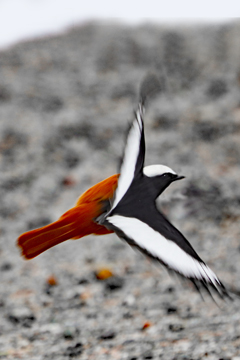
 More of the same today. A welcome surprise was first however. A few people, obviously including me, went out early, and passing an “old” owl box about fifty yards down the road, saw a Scops Owl sitting on
the edge of the hole. I quickly relayed the news back to the hotel, and everyone managed to see the bird before it retreated back inside for the day. Sveta had thought the box unoccupied, as it had been in
previous years. The weather had improved somewhat and we would be able to get further up the mountain, hopefully to find Himalayan Snowcock. Whilst we had brief glimpses of several Accentors the previous day,
better looks were high on most people’s agenda, along with Redstarts. As we drove, no easy task given the amount of snow still around but well-done to our driver, we began to see birds at the side of the road.
Altai (Himalayan) Accentor tried to be elusive, but after several brief views we caught a pair on the way down. Brown Accentor was near the observatory on wires, seemingly waiting to be photographed. A male
White-winged (Guldenstadt’s) Redstart posed on rooftops, and a pair of Rufous-backed showed well. As the group walked back down to the bus the White-winged pair came down to the barrier at the side of the
road, providing great photo opportunities. Also around was a pair of Water Pipits in summer plumage. However, all this was a background to the search for a Himalayan Snowcock, but despite everyone scanning
at varying points we had to be content with distant calls. Usually these birds are easily found given time, but it was not to be that day. Chukar was no consolation whatsoever, even Alpine and Red-billed
Choughs failed to raise interest levels, but nobody was despondent, and we were seemingly rewarded later for our stoicism. We returned down for lunch to the lake overlook, but not before a disagreement with
guards on the way down (something about refusing to pay a bribe), so Sveta decided to spend the afternoon around the picnic area, as it was unlikely that we would find snowcocks now. Instead we (or our leader!)
set us an even harder task, to find the Tit-warbler, which every tour had missed so far this year. This suited most people, since it meant walking in meadows rather than snow, and potentially would turn up a
few more species. People split up but remained in loose contact; one of the first sightings was a Rubythroat, showing even better today on top of Juniper bushes. An even rarer sighting was a female, they are
normally very elusive. A small flock of Fire-fronted Serins entertained us briefly, as did a Hume’s Warbler, and some had a brief glimpse of a Common Grasshopper Warbler. Eventually Sveta began to hear a
quiet song within a bush. We all made our way to the spot, and eventually a small bird was glimpsed in flight. We moved to the bush it disappeared in to, and movement showed it was there, only to fly out
again. This was repeated several times, although it wasn’t flushed, and eventually most people were confident they had seen at least part of a White-browed Tit-warbler. The trail went cold, but as we were
turning round to go back, the sun shone, and the bird (or another) popped up at the top of a bush and remained there for several minutes, singing occasionally. A totally unexpected bonus! (By contrast, they were
much easier on my previous visit but still wouldn't stay still for long).
Back at the bus, just behind the rudimentary toilet, a Sulphur-bellied Warbler was showing outstandingly well, and this was a fitting end to our time in the Tien Shan Mountains. That evening we all said
goodbye to Jonathan, who sadly was the only one of us who was not going on the extension, also one of the best spotters on the trip. There had been a few “dips”, but apart from the Snowcock they would be
hopefully seen in the northern steppes, for some, myself included, this would be the more interesting part of the trip.
More of the same today. A welcome surprise was first however. A few people, obviously including me, went out early, and passing an “old” owl box about fifty yards down the road, saw a Scops Owl sitting on
the edge of the hole. I quickly relayed the news back to the hotel, and everyone managed to see the bird before it retreated back inside for the day. Sveta had thought the box unoccupied, as it had been in
previous years. The weather had improved somewhat and we would be able to get further up the mountain, hopefully to find Himalayan Snowcock. Whilst we had brief glimpses of several Accentors the previous day,
better looks were high on most people’s agenda, along with Redstarts. As we drove, no easy task given the amount of snow still around but well-done to our driver, we began to see birds at the side of the road.
Altai (Himalayan) Accentor tried to be elusive, but after several brief views we caught a pair on the way down. Brown Accentor was near the observatory on wires, seemingly waiting to be photographed. A male
White-winged (Guldenstadt’s) Redstart posed on rooftops, and a pair of Rufous-backed showed well. As the group walked back down to the bus the White-winged pair came down to the barrier at the side of the
road, providing great photo opportunities. Also around was a pair of Water Pipits in summer plumage. However, all this was a background to the search for a Himalayan Snowcock, but despite everyone scanning
at varying points we had to be content with distant calls. Usually these birds are easily found given time, but it was not to be that day. Chukar was no consolation whatsoever, even Alpine and Red-billed
Choughs failed to raise interest levels, but nobody was despondent, and we were seemingly rewarded later for our stoicism. We returned down for lunch to the lake overlook, but not before a disagreement with
guards on the way down (something about refusing to pay a bribe), so Sveta decided to spend the afternoon around the picnic area, as it was unlikely that we would find snowcocks now. Instead we (or our leader!)
set us an even harder task, to find the Tit-warbler, which every tour had missed so far this year. This suited most people, since it meant walking in meadows rather than snow, and potentially would turn up a
few more species. People split up but remained in loose contact; one of the first sightings was a Rubythroat, showing even better today on top of Juniper bushes. An even rarer sighting was a female, they are
normally very elusive. A small flock of Fire-fronted Serins entertained us briefly, as did a Hume’s Warbler, and some had a brief glimpse of a Common Grasshopper Warbler. Eventually Sveta began to hear a
quiet song within a bush. We all made our way to the spot, and eventually a small bird was glimpsed in flight. We moved to the bush it disappeared in to, and movement showed it was there, only to fly out
again. This was repeated several times, although it wasn’t flushed, and eventually most people were confident they had seen at least part of a White-browed Tit-warbler. The trail went cold, but as we were
turning round to go back, the sun shone, and the bird (or another) popped up at the top of a bush and remained there for several minutes, singing occasionally. A totally unexpected bonus! (By contrast, they were
much easier on my previous visit but still wouldn't stay still for long).
Back at the bus, just behind the rudimentary toilet, a Sulphur-bellied Warbler was showing outstandingly well, and this was a fitting end to our time in the Tien Shan Mountains. That evening we all said
goodbye to Jonathan, who sadly was the only one of us who was not going on the extension, also one of the best spotters on the trip. There had been a few “dips”, but apart from the Snowcock they would be
hopefully seen in the northern steppes, for some, myself included, this would be the more interesting part of the trip.
|












